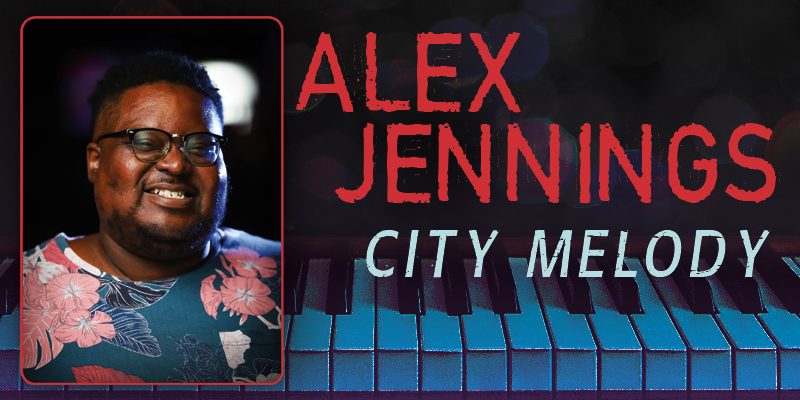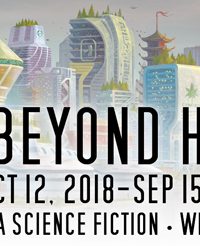Alex Jennings: City Melody

ALEX JENNINGS was born November 30, 1979 in Germany, and lived in Botswana, the US, Suriname, and Tunisia. He settled in New Orleans 16 years ago.
Jennings studied at The Evergreen State College, where he met Octavia E. Butler, who encouraged him to apply to Clarion West. He attended the workshop in 2003, and began publishing short fiction of genre interest with “This is Mars” in 2005. His stories have appeared in Uncanny, Fantasy, and other magazines, as well as anthologies. Some of his short fiction is collected in Here I Come and Other Stories (2012). He is also a poet. His debut novel The Ballad of Perilous Graves appeared in 2022.
Jennings is the director of The Dream Foundry’s Con or Bust program, and writes a poetry review column, “Chapter and Verse,” for F&SF. In 2022, he was the inaugural recipient of the Imagination Unbound Fellowship at Under the Volcano, a writing retreat held in Tepoztlán, Mexico. As of January 2023, he is an instructor at the University of Southern Maine’s Stonecoast MFA program.
“I first wanted to do The Ballad of Perilous Graves as a comic. I was hoping it could be something I could work on and get out very quickly as I waited for my ‘real’ work to take hold. I’d already been publishing some stories here and there, and I had an idea of how my career would go. I thought this was something I could do without being too heavily engaged in it – I could get it published and put it behind me. But it turned out to be the most important work of my career, and the work that’s most representative of me and the way that my mind and imagination function. The book is also a tribute to my city and to my family. It took me ten years to put together.
“One of the things I learned over the years is that there can be a certain hesitancy in a writer inhabiting other bodies fully, and that can create a narrative distance that interferes with the story. So as I was writing and revising and revising and revising, I was always careful to make sure that I was connecting with the senses of my POV characters – at all times, basically. This experience mirrors the visceral experience I’ve had of moving to New Orleans, allowing it to become my home, learning how to live and be here, and how to fully integrate myself with the fabric and the life of this city.
“Katrina happened the year before I moved down here. I had already made the decision to move and I saw it from afar, because I was living outside of Baltimore, and it was heartbreaking. One of the things that I noticed was the stories being told around the storm by outsiders were particularly vicious and often unfounded. There were reports coming out of just a free-for-all of crime and predation in the Superdome that really wasn’t happening.
“New Orleans is a very Black city, and in many ways, the story of New Orleans and the relationship of the rest of the country to New Orleans mirrors the narrative of Blackness writ large in this country. There are outright lies propagated about the city and its people and what they care about, what they do, and how criminality functions here. It was very important to me, in my book, to work to set some of that straight. There is crime here, but there’s also the fact that out of the crime of New Orleans – which has basically been similar all throughout the city’s existence – arose jazz, for instance. Jazz started with the underclass, the criminal class, and it was a gift to the world.
“That dichotomy is so important to the life and cultural contributions of the city and of its people. Those qualities are being eroded by people moving down and buying houses situated right next to bars that have been doing live music for 150 years, and then having the bars shut down with noise complaints. It’s really difficult to watch, and this is just as someone who the city has adopted, not someone born and raised here. It’s so much more painful for the people who come from here originally to see this happen, and to see the way they’re swept aside and ignored. The fact is, the people of New Orleans are responsible for what makes the city run and what makes the city great. They run the service industry, they do everything that makes the city somewhere you would want to be – and yet their needs, their concerns, are so often ignored or outright attacked by these people who are trying to reshape the city in a different image. That struggle was very important for me to depict, even if in a nonauthoritative way, and I think the novel comes out of that.
“I like to say the book is, at heart, a blaxploitation Pippi Longstocking adventure. When I first moved to New Orleans in the wake of Hurricane Katrina, I heard and read a lot of stories of children who were forced to return to the city without their parents, so that immediately made me think of Pippi Longstocking living in her big house with all her animals and no adults to tell her what to do. I began to think, ‘What if Pippi Longstocking was a little redheaded girl living in Central City, New Orleans? How would that context influence her life and adventure and her needs and fears?’ The book grew out of that idea fairly quickly.
“One thing about New Orleans is it’s been in a pitched battle for its soul for some time. There are a lot of people who moved to this city and want to reshape it in the image of where they came from, or some imaginary version of New Orleans they have in their mind that doesn’t relate to the real city. I was hesitant to set a novel in New Orleans as an outsider without spending a long time learning the culture and the music and the history, so one of the ways I tried to stack the deck in my favor was to mainly set the book in this off-kilter, fantastical version of New Orleans, so I’m not taking up space that’s not meant for me or making authoritative statements about the city that aren’t mine to make.
“There is a phrase you hear a lot in New Orleans: ‘Ain’t there no more.’ I knew if I wanted to engage the city in a way that was satisfying to me, I would need to combine multiple eras of the city, so my NOLA is conceived the same way the old Batman: The Animated Series is, where the world is roughly contemporary, but there are a lot of elements of the past – there are a lot of older buildings, and a lot of design coming from the ‘60s, ‘70s, and earlier on. That way I could portray the city as being outside of time, located in eternity, with all of those eras blend into a mélange.
Cover and interview art and design by Francesca Myman
This report and more like it in the January 2023 issue of Locus.
 While you are here, please take a moment to support Locus with a one-time or recurring donation. We rely on reader donations to keep the magazine and site going, and would like to keep the site paywall free, but WE NEED YOUR FINANCIAL SUPPORT to continue quality coverage of the science fiction and fantasy field.
While you are here, please take a moment to support Locus with a one-time or recurring donation. We rely on reader donations to keep the magazine and site going, and would like to keep the site paywall free, but WE NEED YOUR FINANCIAL SUPPORT to continue quality coverage of the science fiction and fantasy field.
©Locus Magazine. Copyrighted material may not be republished without permission of LSFF.







